Understanding Fascia
Have you ever had someone shove something in your face and expect you to read it? Even with great vision it can’t be done. Things so close lose their perspective and are impossible to focus on. And if you can’t focus on something, it’s more difficult to understand. It’s sort of like being relegated to front row of a movie theater.
If you’ve ever sat through a movie on the front row, you realize just how miserable it can be. Sure, it sounds great to those who don’t know better (kids), but those who have experienced it first hand know that it not only makes the experience miserable, but nearly impossible to discern what is taking place on screen. Oh, you can hear the voices and catch bits and pieces of the story line, but you lose your visual reference points when your nose is in the middle of the action.
Without a great deal of effort and discomfort, all you can see is what is directly in front of your face. But change your perspective by moving back to the middle of the theater, and presto; everything clears up. You can see the entire movie screen. You can see the ‘big picture’. This is the sort of phenomenon that the saying, “missing the forest for the trees,” was coined for.
Unfortunately, training for a career in the medical field can be a lot like having a reserved seat on the front row of the theater. You’ll learn a lot of important facts and become fluent in the jargon, but perspective of the magnificence of the human body and the way all the different parts work together in unified order is often lacking.
Our modern medical system has a propensity for pigeonholing. Medicine likes division. You know, subdividing, micro-dividing and then for good measure, further dividing the body into lots of separate parts, systems, and categories. And it’s the same thing with diseases — take a look at a Headache Classification Chart sometime.
Although it seems all neat and orderly on paper, what’s the reality? That those studying for a job in the medical field often times end up with a front row perspective of the structure, function, and dysfunction (diseases / injuries) of the human body.
Think about it; today we have almost every sort of specialist you can imagine (over 200 different kinds). We have kidney specialists (Nephrologists), heart specialists (Cardiologists), nerve specialists (Neurologists), butt specialists (Proctologists), muscle, bone, and joint specialists (Orthopedists), arthritis specialists (Rheumatologists), gland / hormone specialists (Endocrinologists), blood specialists (Hematologists), stomach specialists (Gastroenterologists), female specialists (Gynecologists), etc, etc, etc.
Although this is not always a bad thing, what does dividing the body into lots and lots of separate parts and categories do? It creates a model that can generate extreme disconnectedness as far as PHYSIOLOGY & HOMEOSTASIS are concerned.
This is because division all too often fails to explain how the whole organism can be so much greater than the sum of its individual parts. What do I mean by this? Here is a simple example from 4th grade science class: Hydrogen (an explosive gas) + Oxygen (a flammable gas) = Water (H2O), a liquid — the foundation of all life — that’s actually used to quench fire. This is not a novel concept.
It was Aristotle who came up with this principle almost 2,500 years ago. And if you really took the time to think about it, you yourself could come up with dozens of such examples of this phenomenon that occur within the human body (GUT HEALTH is probably my favorite). But the confusion over the way the body works does not stop there.
The current peer-reviewed literature tells us that even in our ‘connected’ society, it takes two decades for medical schools to begin teaching what’s been ‘proven’ (the word is used loosely in our modern age of industry-controlled “EVIDENCE-BASED MEDICINE“) via scientific research. This means that under even the most favorable conditions, far too many Americans are being treated according to outdated or disproven models —- in many cases, really outdated/disproven models (HERE is a great example). Unfortunately, this phenomenon is dramatically affecting our nation’s Health.
Because “Reductionism” is the name of the game in Medicine, this is the model used by the medical community to explain the workings of your muscles and bones (musculoskeletal system). When it comes to fascia, doctors know what it is and what it looks like, but their model fails to explain what fascia really is, how it really works, why there is so blasted much of it, or why it is of such critical importance to human health. How do I know this?
In most medical textbooks, fascia has been all but totally removed from the anatomical pictures, drawings, and diagrams. I can personally vouch for this, but you can go online and see for yourself. Although quality pictures of muscles, bones, and organs are a dime a dozen, great pictures of fascia are incredibly difficult to find.
And just why is it that the fascia is removed in the first place? That’s easy —- so that everyone can see the “important” stuff — individual muscles. But unfortunately, out of site equals out of mind. And after all; if neither the medical text books, the medical research, nor your medical doctor are talking about fascia, explaining fascia, or showing great pictures of fascia, how important can it really be?
| NORMAL CONNECTIVE TISSUE |
|---|
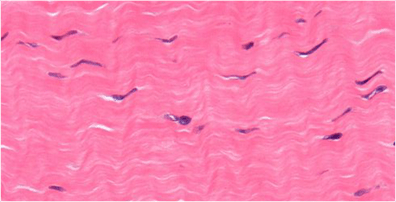 |
| SCARRED & FIBROTIC CONNECTIVE TISSUE |
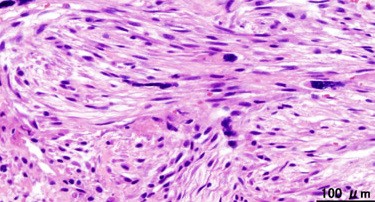 |
What is Fascia?
Fascia surrounds individual muscles, muscle bundles within individual muscles, groups of muscles, blood vessels, and nerves. It binds these structures together in much the same manner that PLASTIC WRAP is used to hold a huge deli sub together.
Consisting of several extremely thin layers, Fascia is the tissue where the musculoskeletal system, circulatory system, and nervous system all unite. It runs from the top of the head to the tip of the toes, and like ligaments and tendons, it contains closely packed bundles of wavy collagen fibers that are oriented in an organized and parallel fashion (picture coming). Subsequently, healthy fasciae are flexible structures that are able to resist great tensile forces. Unhealthy or injured fascia? We’ll get to that shortly.
Fascia’s attachment points extend to all fibrous connective tissues, including the APONEUROSES AND RETINACULUM, LIGAMENTS, TENDONS, joint capsules, the synovium (the fascia-like sheath that covers tendons), organ sheaths / membranes, vascular sheaths / membranes, the epineurium (fascia-like membranous nerve sheaths), the meninges (spinal cord sheaths), the periosteum (fascia-like membranous sheaths that surround bones), as well as the membranes that surround individual MUSCLES.
Although these tissues have different names (they are named according to where they are found in the body), they are all basically made of the same “stuff” and either directly or indirectly connect every part of the body to every other part of the body (HERE).
Among the different kinds of tissues that are involved in the body’s ‘elastic’ framework, fascia has received the least scientific attention — probably because in most regions of the body it cannot be diagnostically imaged with even the most technologically advanced imaging techniques such as MRI (HERE — there is, however, brand new technology that is growing in popularity and use — HERE). Nevertheless, fascia plays a major role in joint stability / instability, PROPRIOCEPTION, coordination, strength, joint motion, flexibility, as well as CHRONIC PAIN SYNDROMES of all kinds.
Critical Functions of Healthy Fascia
- It acts like an anatomical “girdle” to bind and hold muscles together in a compact manner.
- It maintains the proper position of the individual muscle fibers, blood vessels, and nerves within the muscles, and prevents them from moving all over the place during movement or muscle contraction.
- It helps prevent injury by evenly distributing forces and loads for uniform transmission of these forces and loads over the whole muscle.
- It creates a uniformly smooth / slick surface that essentially lubricates the various tissues that come in contact with each other during movement. This is helps prevent friction injuries and subsequent tissue degeneration and degradation.
- It allows muscles to change shape as they are both stretched and shortened (contracted).
Anatomical Pictures of Fascia
| THORACOLUMBAR FASCIA |
|---|
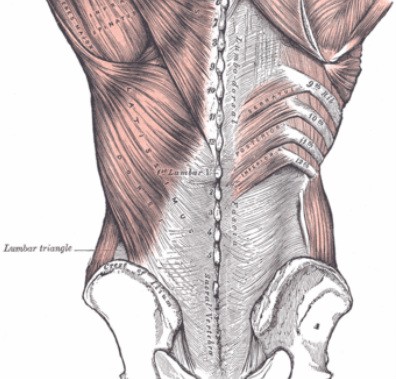 |
| HIP FLEXOR FASCIA |
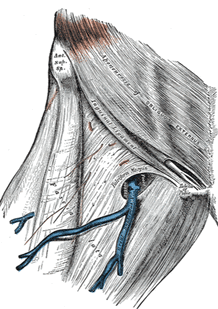 |
| ABDOMINAL FASCIA |
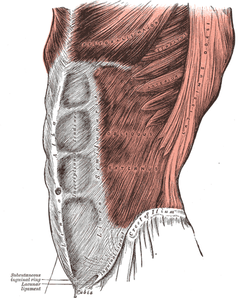 |
| SKULL FASCIA |
 |
These pictures from the famous 1858 textbook, Gray’s Anatomy, were included to show you just how much fascia there is in the body that most of us have never even thought about. The fascia in these particular areas is responsible for low back pain (THORACOLUMBAR FASCIA), HIP FLEXOR PROBLEMS, SKULL PAIN (not to be confused with headaches), as well as ABDOMINAL PROBLEMS. In some places the fascia is very thick, while in others, the fascia is much thinner — almost translucent —- but regardless, it’s everywhere.
Collagen’s Relationship to Fascia
Collagen is the building block of all connective tissues. Some collagen-based connective tissues like bone and most cartilages, are part of your body’s load-bearing framework. Their purpose is to withstand compressive forces, while grossly maintaining the body’s shape. They prevent the body from deforming underneath mechanical loads.
On the other hand, you have the Elastic, Collagen-Based, Connective Tissues (ligaments, tendons, and fascia), whose chief job is to overcome the tensile forces that are constantly trying to pull joints apart whenever movement or muscle contraction takes place. These tissues don’t need to be able to bear heavy loads, but instead, must be able to stretch, elast, and “deform” (at least to a slight degree) while resisting tearing. Of these tissues, fascia is the most elastic, while tendons are considered the least elastic (some say that tendons are actually non-elastic).
As long as the individual collagen fibers that make up the fascia, are aligned in parallel fashion to each other (see picture above with collagen fibers superimposed over a sheet of fascia), the tissue is smooth, stretchy, wavy, and elastic. Think about long hair that has been combed out. If you run a comb or brush through it, it glides — smoothly and unrestricted. But what happens when Fascia is injured? As you can imagine, it’s not good!
When Fascia is stretched beyond its normal tensile capacity, it begins to tear. Bear in mind that these tears can be so microscopic that they never show up with our current arsenal of advanced imaging techniques such as MRI. These “Fascial Tears” can be caused by SPORTS INJURIES, REPETITIVE TRAUMA, CAR WRECKS, POSTURAL DISTORTIONS, FALLS, CHILD-BEARING, ABUSE, etc, etc, etc. Oftentimes people have no idea how they ended up with Fascial Injuries, because they can be caused by wear and tear over time (not to mention, INFLAMMATION).
Here’s the good news / bad news part of this scenario. Fortunately, these Fascial Tears will heal. Unfortunately, they often heal incorrectly — in a tangled, twisted, “wad” of connective tissue (HERE). And whether you realize it or not, there are always consequences to having restricted connective tissues — particularly fascia in the form of “Fascial Adhesions” in your body.
Casts, Nets, and Cross-Links in Fascia
Whenever a muscle is impacted (contact sports, falls, abuse, etc) or overused / over-stretched (lifting weights, running, over-training, heavy or repetitive jobs, etc), collagen microfibers form in between adjacent layers of fascia and bind them together. The body does this in order to make a sort of internal “cast” so that the muscles can heal. Unfortunately, these microfibrils do not automatically go away after the area has healed, and they tend to accumulate over time. As you can imagine, this is not a good thing.
Like the cross-links on a net, the more of them there are, the stronger the net will be — but the less elastic the net will be as well. In the body, this means that over time, the elastic, collagen-based tissues (particularly muscles and fascia) get increasingly stiffer and less stretchy (HERE is a ten second video of what this actually looks like). If you’re MY AGE, you know what I’m talking about.
Is there evidence for Fascial Adhesions caused by collagen cross-links — the bridges that connect individual Collagen Fibrils? Although it is well known that collagen strength and stability is greatly affected by collagen cross-links, we now know that over time, the by-products of sugar metabolism as well as sugar itself accumulate in both fascia and tendons (HERE). Despite the fact that his actually makes the tissues stronger (at least initially), it also makes them significantly less elastic.
When these thickened tissues fail, the resulting healing process leaves fibrils that are much smaller, making them more prone to re-injury and even rupture. The result of this “uncontrolled” healing process is a tissue matrix (ECM) that is no longer highly organized, but weaker, less elastic, and randomly organized. This leaves us with tissue that has decreased functional capacity and more prone to the vicious cycle of injury and degeneration.
You can also think of the collagen found in fascia in terms of a Slinky. Normal collagen has waves in it — kind of like the coils in a Slinky. The coils of a Slinky act like waves and give it the ability to elast and stretch in response to tensile forces. As long as the load is not too great to overcome the metal’s tensile strength, the Slinky can ‘spring back’ — and everything continues as normal.
However, if the most elastic of the collagen-based tissue (fascia) is forced to bear more tensile load than it can handle, tissue failure begins to occur. The tissue loses its ability to stretch and elast.
Think of this as a Slinky that has been stretched out to the point of failure. The material has not necessarily broken, but it has been stretched far enough that it is not going to “spring” back like it should. This leads to tangles, which is a whole other problem unto itself. We have all experienced a mangled Slinky before. It does not function as it should. This is how Fascial Adhesions work, and is often referred to as “FIBROSIS“. Allow me to show you some analogies that will help you better understand what I’m saying.
Put both of your hands flat on a table in front of you, and slide the fingers of one hand back and forth between the fingers of the other. This is similar to the way that fascia works, and is what gives connective tissues, including fascia, an incredible amount of stretchiness and flexibility. Normally functioning fascial membranes are not only arranged in a very organized and parallel manner, but if you were to look at them on edge, they are flat and smooth — like a piece of paper.
Once fascia is injured (HERE are some of the specific ways that fascia tears), the microscopic fibers become disrupted and deranged. Instead of the fibers running parallel to each other in an organized fashion with their normal degree of elasticity / flexibility, the fibers now run every possible direction in all three dimensions and have an extremely diminished amount of organization and elasticity.
Interlock the fingers from one hand with the fingers from the other, only now do it with the fingers pointed in all directions. Now try to slide the hands back and forth. See the difference in flexibility?
Also notice that when the fingers are interlocked randomly, they will no longer lay flat on the table. Facial Adhesions act the same way. When fascia is injured, individual fibers run every which direction, in all three dimensions, meaning that not only does the injured tissue loose its elasticity, the cellophane-thin fascial membranes no longer lay flat like a piece of paper. Instead, they are more like a wadded up or crumpled piece of paper.
We can also think of this fascial scarring and adhesion in terms of hair. Remember our example of well-manicured hair that a comb or brush glides through easily? Now think of the exact opposite. Think of a HAIR TANGLE. What happens to hair that is not well taken care of or was slept on wet?
Instead of the individual hair follicles lying parallel to each other in a neat and orderly fashion, they become tangled, with the individual hair fibers running in every conceivable direction. The result is a tangled mess — a ball of hair that takes forever just get a comb or brush through it. “Hair balls” can be so restrictive that just trying to get a comb through it, pulls and causes great pain.
This is even more true with fascia, potentially leading to great pain-sensitivity. When the organization of the parallel collagen fibers of fascia is disrupted by injury, a host of really bad things begin to happen. The first thing that occurs is restriction of joint motion. Understand that if you have tissue restriction, you will automatically have some degree of loss of normal joint motion and PROPRIOCEPTION in the corresponding area(s) of the body.
Also understand that loss of normal joint motion virtually assures you that sooner or later there will be pain — even if you are not yet experiencing pain. Again, this is because according to the latest research, SCAR TISSUE can be over 1,000 times more pain-sensitive than normal tissue (HERE). Unfortunately, pain may not the worst thing that is caused by loss of normal joint motion. That would be degeneration.
Loss of, or abnormal joint motion, is one of two known causes of localized joint degeneration (THIS IS THE OTHER). When I speak of “localized joint degeneration,” I am talking about things like calcium deposits, bone spurring, and loss of articular cartilage or disc height that occur in injured joints or Spinal Discs.
Degeneration is a great example of a vicious cycle: Abnormal joint motion causes joint degeneration —– and joint degeneration causes abnormal joint motion. Repeat. As this cycle spins around and around, it frequently (BUT NOT ALWAYS) causes increasingly severe pain —- pain that can turn into TYPE III or Chronic Pain.
Pain is frequently nothing more than a by-product of the vicious cycle. This is why meds like PAIN PILLS, MUSCLE RELAXERS, ANTIDEPRESSANTS, and other pharmaceutical measures, mask symptoms of Chronic Pain (ineffectively, I might add) without ever really addressing its underlying cause. And the kicker is that some of the most popular musculo-skeletal drugs actually add to the degenerative effect (NSAIDS & CORTICOSTEROIDS).
In many cases of Chronic Pain, the underlying cause is SUBLUXATION, fascial restriction / adhesion, and microscopic scar tissue. This is why knowing how restrictive abnormal tissues can be goes a long way toward explaining why adjustments never seem to hold more than a few days or even a few hours in many patients (HERE).
How problematic is this whole scenario? Think about it for a moment. Fascia is the single most pain-sensitive tissue in the body — yet it does not image well with even the most advanced imaging technologies such as MRI. Those of you who have dealt with Chronic Pain long enough, know exactly what it means. It means that when you go visit various doctors (orthopedists, pain specialists, neurologists, etc) they run all sorts of tests, and then look at you as though you are crazy.
Or maybe they look at you like you’re a drug seeker. Or trying to get Social Security Disability. Or maybe they just chalk it up to hard work and too many sports. Or maybe they just tell you that you have arthritis or FIBROMYALGIA just to get you out of their office. Or maybe they used that old and trusted standby, ‘After all Mrs. Smith, you just aren’t as young as you used to be.‘
Whatever the case, the result is almost always the same — blank stares and the recommendation for more pills, more procedures, more shots, and more tests. Could there possibly be better solutions? MANY OF MY PATIENTS certainly think so!

Because Tissue Remodeling actually breaks the Fascial Adhesions and subsequent tissue restrictions that cause so many symptoms, there is often some bruising associated with the technique. Microscopic scarring is a dense, inelastic, random, and unorganized mess.
Nonetheless, scars (even the microscopic kind) are living tissue with a blood supply in the form of a capillary bed (capillaries are blood vessels so tiny that red blood cells must move through them in single file). This means that when I break the adhesion, I break the blood supply right along with it.
There will be some internal leaking of red blood cells from the scar’s capillary bed into the surrounding tissue. Please don’t panic. In plain English, this means that you will have a bruise. It’s not uncommon that this bruising can be scary looking. You can visit our BRUISING & PICTURES PAGE to see why this is no big deal. If the thought of bruising makes you a bit nervous, just visit our TESTIMONIAL PAGE to see the end results of many of those who have been treated in this manner.
Does breaking Fascial Adhesions always work? Of course not. But if your chief underlying problem is Fascial Adhesion and Microscopic Scar Tissue of the Elastic, Collagen-Based Tissues, you must address these in order to facilitate a long-term recovery (HERE, HERE, and HERE).
The Difference Between Scar Tissue, Adhesions, Fibrosis, and Fascial Adhesions
By now we should have an idea of what Scar Tissue and Adhesions look like on a microscopic basis, as well as how they act. Bear in mind that much of the time, Scars and Adhesions are thought of as something that is visible to the naked eye, while Fibrosis is something that occurs microscopically. While most pathologists would probably chastise me for saying this (HERE), I use these words interchangeably.
FIBROSIS is said to be the formation of excess fibrous connective tissue in an organ or tissue. This excess Connective Tissue is laid down in response to an injury, but can also be the result of a reaction (or hyper-reaction) seen in various disease processes (Cystic Fibrosis, Pulmonary Fibrosis, Cirrhosis of the Liver, Crohn’s, Disuse Atrophy, etc).
Visible scarring is seen when microscopic Tissue Fibrosis becomes so prevalent that it begins to obliterate the normal architecture of the affected organ or tissue. Also understand that sometimes you will see the word “Fibrosis” used to describe the normal healing process. Although this may technically be true, I will never use the word in this fashion.
Also, be aware that to some extent, the model for describing Fascia is changing. It seems that we are learning that many of these adhesions are actually “DENSIFICATIONS” as opposed to “Scar Tissue”.
| TENDON SHEATH FIBROSIS (TENOSYNOVITIS) |
|---|
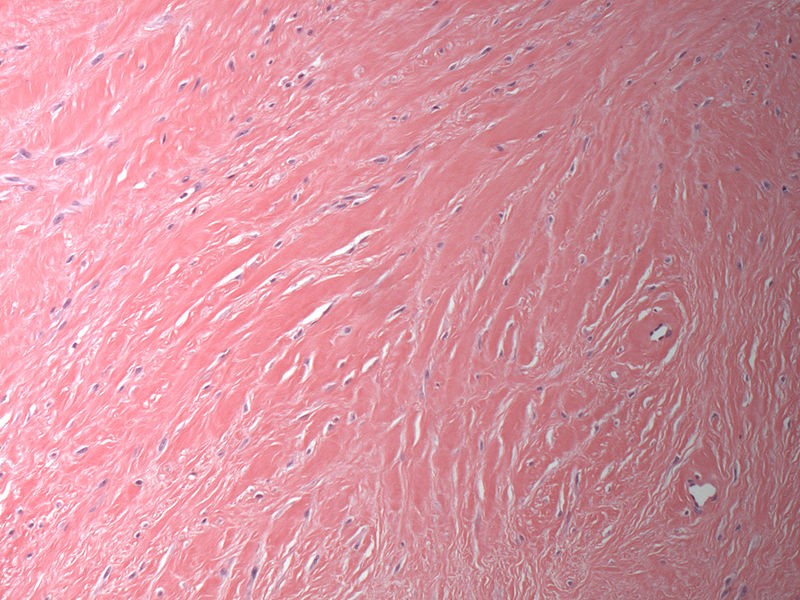 |
| FIBROTIC TISSUE OF THE SKIN (SCAR TISSUE) |
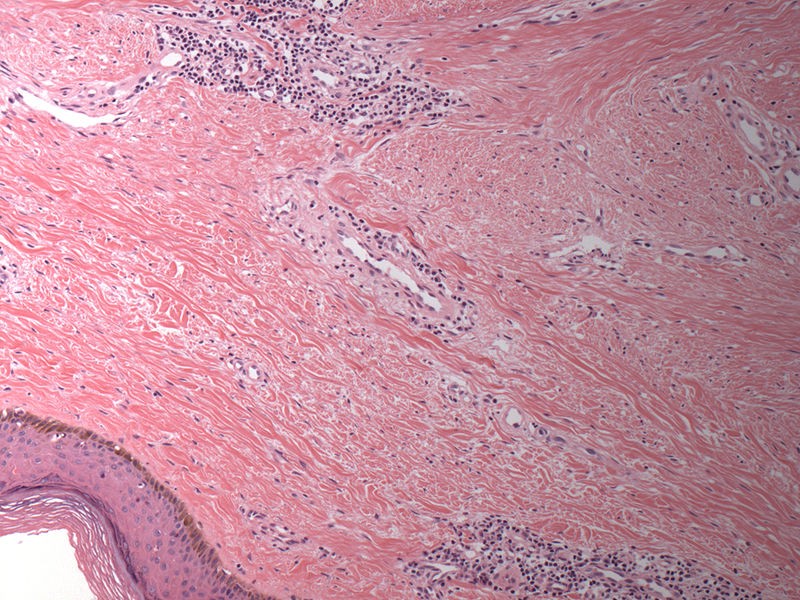 |
The thing I want you to notice in every picture of Fibrosis / Microscopic Scar Tissue / Microscopic Adhesion on this page is that the individual tissue fibers are not lined up in a parallel fashion when compared to normal, healthy Connective Tissue. One last time, it is the organized and parallel nature of the Elastic, Collagen-Based Connective Tissues (ligaments, muscles, tendons, fascia) that give them their incredible strength and flexibility.
When you look and see how these fibrotic tissues swirl around in various random patterns, you begin to understand why this sort of tissue is much weaker and far less elastic than normal tissue. This lack of strength and flexibility is what leads to chronic re-injury and degeneration. But as you’ll quickly see, the problem is just getting started.
Forget About Your Pain for a Moment: Fascial Adhesions as the Basis for All Disease
There are four types of tissue in the body. Epithelial Tissue, Muscle Tissue, Nerve Tissue, and Connective Tissue. The Connective Tissues that I primary deal with in my clinic are Bone, Fascia, Ligaments, and Tendons. Once you start to understand a little bit about the way the body functions, it is not a reach to grasp how big a part Fascial Adhesions play not only in the development of Pain Syndromes, but the development of various disease processes as well (HERE).
As shocking as it might seem, there are some big names in academia who are touting adhesed fascia as the root cause (not just “a” root cause) of all NON-GENETIC pain, sickness, and disease.
The beauty of gentle Chiropractic Adjustments coupled with Scar Tissue Remodeling is that they not only help relieve pain while restoring range of motion, they actually allow the nerve system and the various functions controlled by the nerve system (basically everything) to function closer to the way they were designed and created to function in the first place (HERE —- or read REX’S TESTIMONIAL of having 42 years of deafness solved with a single treatment to his neck).
For more information about the amazing properties of fascia as well as it’s importance, make sure to read by post called WHY FASCIA? TWENTY FIVE REASONS WHY FASCIA! To better understand the entire process of Inflammation, Fibrosis, Degeneration, Chronic Illness, and even death as it relates to fascia, take a moment to read THIS POST. CLICK HERE TO SEE OVER 160 POSTS ON FASCIA

3 Responses
Hello Dr Schierling. We’ve communicated before. I know no other website with such a useful compilation of the best knowledge about fascia and connective tissue. I believe that most people with what is really “Fibromyalgia” (as opposed to Doctors just using it as a convenient label for people with other problems they don’t understand) have a body-wide, systemic dysfunction in their fascia and connective tissue that goes beyond what we understand as “injury” – which is of course site-specific. I spent 25 years getting worse with Fibromyalgia, and then 7 years getting slowly better. Finally my research and self-experimentation chanced on a mixture of self-treatments, therapies and lifestyle changes that worked. I wish “getting better” only took months rather than years – but I am still getting better, and the better I get, the worse I realize my condition in the past actually was. Because I am curious and obsessed, and talk to a lot of people, I am now adamant that some unlucky people have an innate vulnerability to a biochemistry dysfunction that creates body-wide fascia immobility. Those who get this condition do mostly seem to share some environmental and life factors: stress; elevation of one or more toxic elements (HTMA reveals); an accident or operation; and the wrong kind of activity for staying flexible (neglecting stretching, etc). I was a hardened road-racing cyclist when I succumbed; which I believe did not help compared to had I been a gymnast or dancer.
But of course (and I keep meeting people like this) many people do suffer these factors, even in combination, without getting Fibromyalgia. Fibromyalgia does seem to “run in families”. So I argue that what medical science needs to discover, is what is the genetic aberration that makes some people vulnerable to their entire fascia and connective tissue having its biochemistry upset, and becoming immobile, limiting of movement, and a cause of frequent injury, especially of the “pinching” type. In some cultures, there is a traditional torture / execution method where the victim is wrapped in wet leather which crushes them as it dries, shrinks and hardens. To an obviously lesser degree, I say that visualizing the fascia doing this everywhere in the Fibromyalgia victim, has major explanatory power for the kind of pain we are in.
I utterly reject the hypothesis that we merely have “over-active nervous systems that amplify what is nothing more than normal aches and pains”. Yes, we do have over-active nervous systems BECAUSE of the chronic load of REAL pain. In fact I argue that the CNS is so overloaded, we are unable to even feel the pain coming from everywhere at once; it is the few spots that are the “most injured” at any one time, that we are aware of – and these are real agony in their level. Put prod us anywhere, and it is like being prodded on a raw wound – we weren’t aware of it before being prodded, but it is there nevertheless. Besides the dysfunction of the fascia itself, the restriction of movement of interstitial fluids results in reservoirs of trapped toxins all over the body, akin to “infection”. This is part of a vicious circle in which the victim has become trapped, because obviously the fascia itself is likely to become even more biochemically imbalanced as toxin load increases.
The reason “getting better” takes years, is that this vicious circle has to be patiently reversed; toxins flushed out (and no addition of toxins meanwhile eg by careful diet and lifestyle habits); fascia hydrated and mobilized; more toxins flushed out; and so on. I believe this process proceeds “layer by layer”; the most intransigent location is all the big connective-tissue attachment points around the pelvis. I am still flushing out and mobilizing this area. As deeper locations are flushed out and released, there are flare-ups in the lower legs and feet as the released toxins seep downwards initially before the renal system can remove them completely.
I am completely unable to find any expert research attention to this possibility. People who are meant to be “Fibromyalgia experts” largely ignore the fascia and focus on the nervous system – and “Fascia experts” seem to be ignoring the possibility that there is an actual disease that affects fascia and connective tissue throughout the body; as opposed to injury and misuse creating mostly-local issues that can be cleared up with one, two, or a few treatments, and a few months of the right “exercises”.
Dear Russell, my name is Scott Little. I am a chiropractor and animal chiropractor and founder of the forthcoming, Animal Chiropractic Academy. We are a 220-hour certification program for chiropractors and veterinarians to learn Animal Chiropractic.
Even before covid there was a trend towards blending online with hands-on learning in the Animal Chiropractic world. Our program is about 120 hours online and 100 live. We pay significant attention to connective tissue and fascia, and the interrelationship between the neuro-fibro (or fascial)-musculoskeletal system.
I’m reaching out to see if you would be willing to do a zoom interview with me as part of our online material, discussing fascia, what it is, how big of a deal it is, and perhaps, it’s relationship to pain, chiropractic, subluxation, injury, emotional trauma, etc. Your audience would be chiropractors and veterinarians.
You can check out our website at http://www.animalchiropracticacademy.com. We intend to host our first class in 2021.
Thank you in advance for even the consideration. I have learned a lot from your blog, and over the past couple of years, have really been diving into fascia and its relationship to chiropractic – especially in horses and dogs. I will look forward to your response.
Scott
Scott, I realize it’s a long time after the fact, but I would be willing to do this. I have been involved in migrating my (huge) site from one platform to another and it has been a full-on project. Get back to me in a month or so and we will set something up.